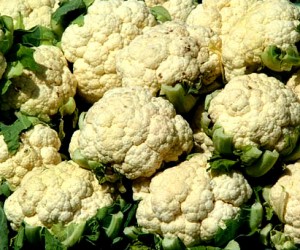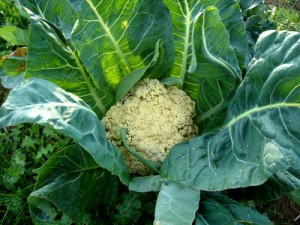 Cauliflower is considered as the aristocrat vegetables in the species Brassica oleracea, in the family Brassicaceae. Brassica oleracea also includes cabbage, brussels sprouts, kale, broccoli and collard greens, though they are of different cultivar groups. Cauliflower and broccoli are the same species and have very similar structures, though cauliflower replaces the green flower buds with white inflorescence meristem. It is an annual plant that reproduces by seed. Typically, only the head (the white curd) of aborted floral meristems is eaten, while the stalk and surrounding thick, green leaves are used in vegetable broth or discarded. Cauliflower can be eaten raw or cooked in a number of ways including boiling, baking and sautéing. Whole cauliflower heads may also be cooked in one piece.
Cauliflower is considered as the aristocrat vegetables in the species Brassica oleracea, in the family Brassicaceae. Brassica oleracea also includes cabbage, brussels sprouts, kale, broccoli and collard greens, though they are of different cultivar groups. Cauliflower and broccoli are the same species and have very similar structures, though cauliflower replaces the green flower buds with white inflorescence meristem. It is an annual plant that reproduces by seed. Typically, only the head (the white curd) of aborted floral meristems is eaten, while the stalk and surrounding thick, green leaves are used in vegetable broth or discarded. Cauliflower can be eaten raw or cooked in a number of ways including boiling, baking and sautéing. Whole cauliflower heads may also be cooked in one piece.
The name of this elegant member of the cabbage family comes from the Latin caulis (“stalk”) and Floris (“flower”). Cauliflower comes in three basic colors: white (the most popular and readily available), green and purple (a vibrant violet that turns pale green when cooked). All cauliflower is composed of bunches of tiny florets on clusters of stalks. Some white varieties have a purple or greenish tinge.
Cauliflower is low in fat, high in dietary fiber, folate, water and vitamin C, possessing a very high nutritional density. As a member of the brassica family, cauliflower shares with broccoli and cabbage several phytochemicals which are beneficial to human health, including sulforaphane, an anti-cancer compound released when cauliflower is chopped or chewed. A high intake of cauliflower has been found to reduce the risk of aggressive prostate cancer.
When purchasing cauliflower, look for a clean, creamy white, compact curd in which the bud clusters are not separated. Spotted or dull-colored cauliflower should be avoided, as well as those in which small flowers appear. Heads that are surrounded by many thick green leaves are better protected and will be fresher. Store uncooked cauliflower in a paper or plastic bag in the refrigerator where it will keep for up to a week. To prevent moisture from developing in the floret clusters, store it with the stem side down. If you purchase pre-cut cauliflower florets, consume them within one or two days as they will lose their freshness after that. Since cooking causes cauliflower to spoil quicker, consume it within two to three days of placing in the refrigerator after cooking.
Growing Cauliflower
Varieties:
- F1 Hoggar – Heat resistant early maturing 55-65 days from transplant. Curd is white, medium round, weighing 8 to 1 kg. Dark green leaves with medium frame.
- F1 Farwa – very rustic hybrid and large scale. Climatic adaptation: for November to February. Curd – deep white, round shape – closed cover.
- Other Tropical varieties include: Snow Ball Y, F1 Monte Pearle, F1 Blanca, F1 Palma, and F1 Jana.
Soil and Climatic Requirements
Cauliflower is sensitive to high acidity. Where soil reaction ranges from pH 5.5 to 6.6 maximum yields could be obtained. It grows best in rich heavy loamy soils, although it thrives fairly well in light soils. Low and well-drained bottom lands give good results if climatic conditions are favorable. Cauliflower requires a cool, moist growing season. It can not withstand either low temperatures, or too much heat, dry weather and low humidity. It succeeds better when the days are short.
Seed Requirements
About 200 to 300 g of seeds are enough to plant one hectare. The seedling are taken cared of in the same way as in cabbage, although greater care must be exercised by providing moderate rich soils and disinfecting the seedbeds or seed boxes. Although pricking is uncommon among growers, it is a must operation in cauliflower growing to produce uniform and stocky seedlings for field planting.
Land Preparation and Fertilization
The land should be well-prepared before the seedlings are set in the field. The field is plowed as many times as necessary, each followed by harrowing, until a fine filth is obtained. Cauliflower requires greater fertility than cabbage. It obtainable, large amounts of rotten manure may be use to advantage especially in light soils. With about 5 tons of manure per hectare, the application of about 100-45-45 kg. of N-P-K fertilizer mixture per hectare may prove beneficial. The application of 150-45-45 of N-P-K fertilizer mixture per hectare would give good results.
Transplanting and Care of Plants
Seedling, pricked or unpricked, are ready to be transplanted 35 to 45 days from sowing. The seedlings are set in double rows at intervals of 50 cm apart. Each double row is 100 cm apart. Newly-set seedlings should be watered and/or irrigated by flash system to prevent the occurrence of too many missing hills. As soon as the developing plants are about 15 cm. tall, they are topped dressed with nitrogen fertilizer at the rate of about 20 kg. of the pure element per hectare, after which the double rows are bedded either with the use of machines equipped with a ridge or with a plow. Bedding the double rows is advantageous in that the plants are provided with a soil mulch which curtails the growth of weeds, completely eliminates cultivation and facilitates irrigation by merely allowing the irrigation water to play in-between beds until the desired soil moisture is reached.
A perfect cauliflower head is pure white. This whiteness of curd can be obtained by blanching. While the heads are still small, the outer leaves are brought up over the head and fastened together with a bamboo toothpick for a period of two to three days. The outer leaves fastened together should be opened after three days as prolonged blanching may result in discoloration of the curd.

Harvesting, Curing and Storing
The curds should be harvested as soon as they reach the proper size and before discoloration begins. Since the curds mature rather fast and sometimes irregularly, harvesting should be done frequently and regularly. The head or curd should be cut with one or two circles of outer leaves to protect the curd from bruises and damage. The curds are packed with the outer leaves untrimmed.
Control of Pests and Diseases
- Pests and their Control: The most common insect pest of cauliflower are cutworms (Spodoptera litura Fabr.) cauliflower worm (Crocidolomia binotalis Zeller), diamondback moth (Plutella Xylostella Linnaeus), and root grub (Leucopholis ittorata). For the control of cauliflower worms and diamond-back moth, spray the plants with any of the following: Foliafume 1 tbs. per gallon of water, Sevin 1 tbs. per gallon of water, Malathion 1 tbs. per gallon of water, Root grub can be controlled by treating the soil with Alder 2 at the rate of 1 tbs. in 1 gal. of water.
- Diseases and their Control: Cauliflower, like any other vegetable, is subject to the attack of plant diseases. The most common diseases are club root, soft rot, bacterial leaf spot, downy mildew and root knot of vegetables. The first it can be controlled by sterilizing the soil with mercuric bichloride or formalin (1:1000) and/or lime application in the soil. Bacterial leaf spot and downy mildew may be greatly minimized by foliar sprays with copper fungicides at the rate of 3 to 5 tbsp.per 5 gallons of water at 7 to 10 day intervals.
Generally, crop rotation, use of well-drained soils, good management practices and avoiding heavy seeding in the seedbeds help prevent the occurrence of plant diseases.
Source: Cultural Directions for Phil. Agricultural Crops; Photos: ourhomeremedies.com